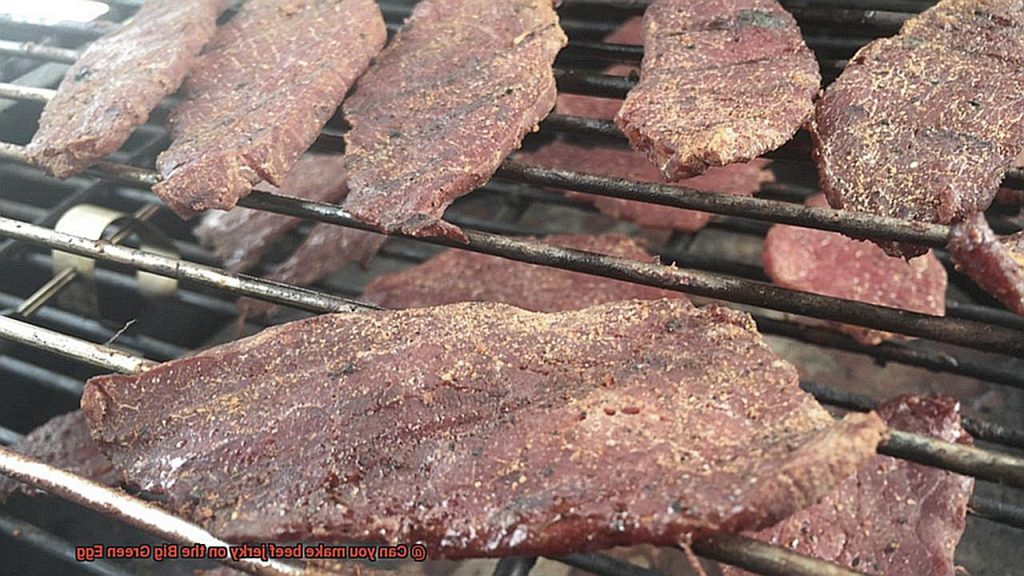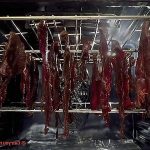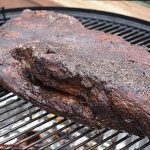Are you a fan of the smoky, savory deliciousness that is beef jerky?
Do you happen to own the versatile cooking powerhouse known as the Big Green Egg? Well, get ready to up your jerky-making game because this bad boy can do it all.
The Big Green Egg isn’t just your average grill or smoker—it’s a culinary beast that can handle any cooking technique you throw at it. And if you’ve ever wondered whether you can make beef jerky on this beauty, prepare yourself for a mouthwatering surprise.
So, grab your apron and let’s fire up that grill for a flavor-packed adventure.
Contents
Equipment and Ingredients
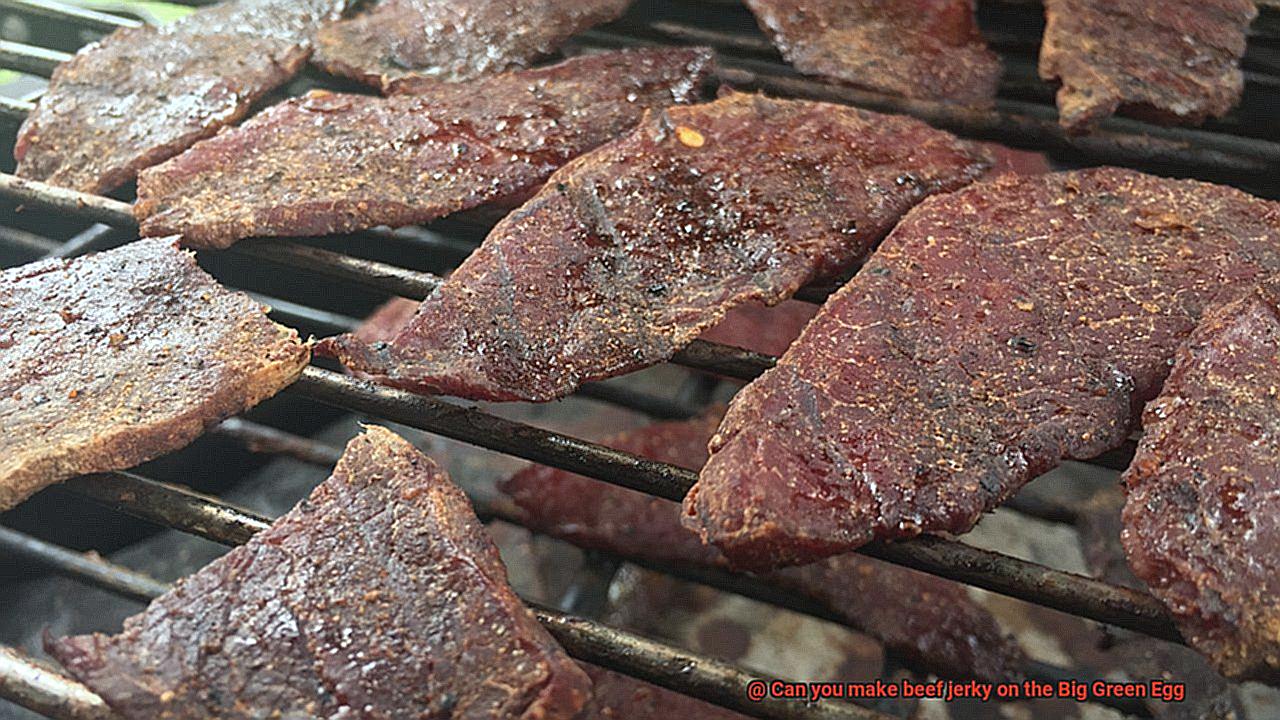
With its unparalleled temperature control and unrivaled versatility, the Big Green Egg stands as the ultimate tool for crafting succulent homemade beef jerky. In this comprehensive guide, we will expertly navigate through the essential equipment and ingredients required to create tantalizing beef jerky on your Big Green Egg.
Essential Equipment:
- Big Green Egg: Behold the star of the show, the kamado-style grill that reigns supreme. This culinary marvel boasts exceptional temperature control, making it an indispensable asset in the quest for perfect beef jerky.
- Smoking Chips or Chunks: Select from an enticing array of hickory, mesquite, applewood, or cherry wood to infuse your beef jerky with bewitching smoky nuances that will captivate your taste buds.
- Drip Pan: Position a trusty drip pan beneath the cooking grate to expertly intercept any heavenly drippings or marinade that may cascade from the meat during the cooking process. Not only does this simplifies cleanup, but it also prevents unwelcome flare-ups.
- Grill Grate: Embrace a top-tier stainless steel grill grate, meticulously chosen for its ability to distribute heat evenly and ensure optimal airflow while coaxing your beef jerky to perfection.
- Meat Thermometer: Entrust your culinary masterpiece to a steadfast meat thermometer, diligently monitoring its progress and confirming that your beef jerky has attained its desired level of succulence and safety. Aim for an internal temperature of approximately 160°F (71°C) to savor fully cooked jerky.
Essential Ingredients:
- Beef: Embark on your quest for beef jerky greatness by selecting lean cuts such as the eye of round, top round, or bottom round. Prioritize removing any excess fat before artfully slicing this meaty canvas.
- Marinade: Weave a tapestry of flavors by skillfully crafting a tantalizing marinade. Transcend culinary boundaries with a harmonious blend of soy sauce, Worcestershire sauce, liquid smoke, garlic powder, onion powder, black pepper, and an assortment of spices or seasonings to reflect your personal gustatory vision.
- Salt: Elevate your beef jerky’s flavor profile by harnessing the power of kosher salt or sea salt. Not only does this preserve the meat, it also bestows an enchanting savoriness upon your creation.
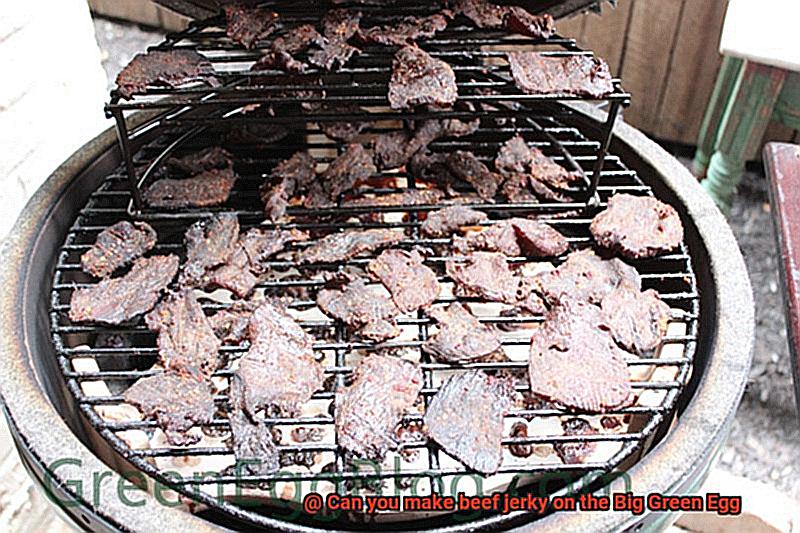
Choosing the Right Cut of Beef
If you’re a connoisseur of beef jerky and pride yourself on owning a Big Green Egg, get ready for a tantalizing treat. But before you ignite that kamado-style grill, let’s explore the art of selecting the perfect cut of beef for your homemade jerky.
The secret to exceptional jerky lies in the cut of beef you choose. It’s the difference between a chewy, lackluster snack and a mouthwatering, flavor-packed delight. So, let’s delve into some research notes to equip you with the knowledge needed to make an informed decision.
Let’s start with the crown jewel of jerky cuts: the eye of round. Nestled in the hindquarter, this lean cut boasts tender meat and a subtle flavor. Its minimal marbling makes it ideal for drying and preserving, ensuring optimum taste and texture. Next on our list is the top round, equally lean and sourced from the upper rear leg. It offers a slightly bolder flavor profile while still delivering remarkable results.
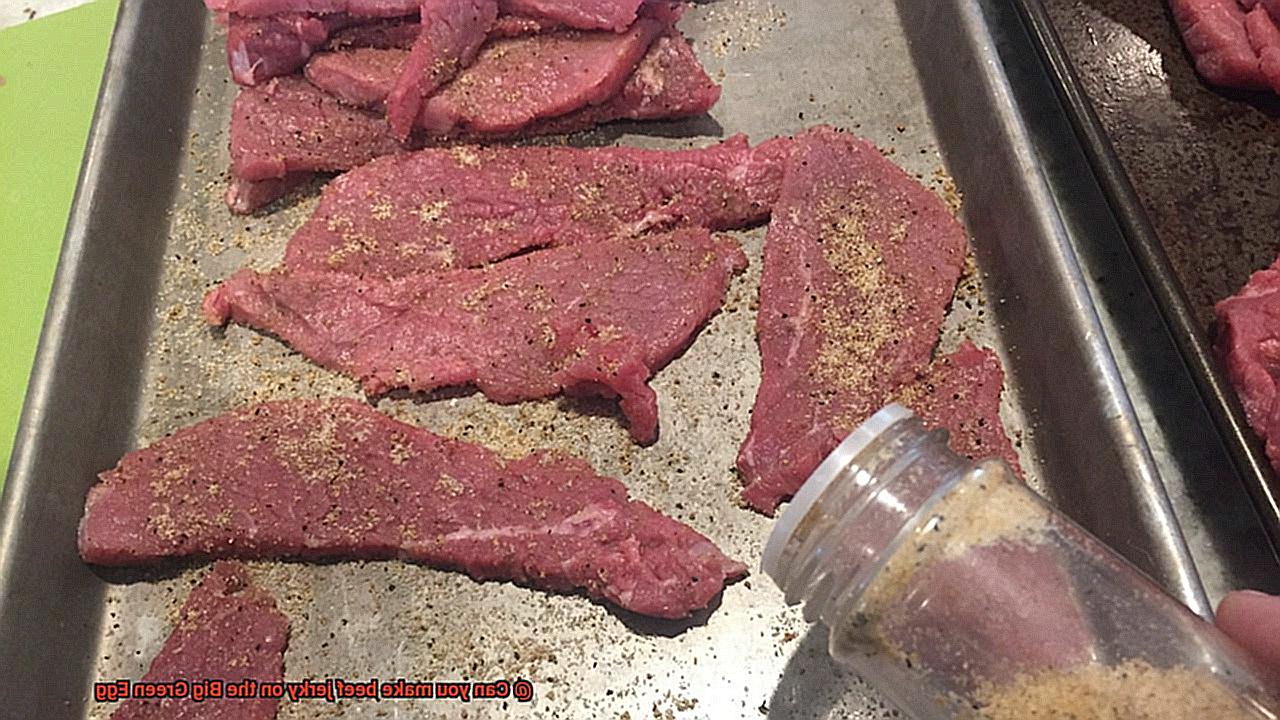
Feeling adventurous? Give the bottom round a whirl. This cut may be leaner but possesses more toughness compared to the eye or top round. Fear not though, as thin slices against the grain, combined with proper marination and tenderization techniques, can transform it into delectable jerky.
Looking for further options to tantalize your taste buds? Consider flank steak and sirloin tip. Flank steak boasts an intense beefy taste, while sirloin tip offers a milder flavor and enhanced tenderness. Both cuts have their merits when it comes to jerky-making, but they may require additional marination or tenderizing methods to achieve optimal results.
When selecting your cut of beef, remember to avoid excessive fat or connective tissue. Fat doesn’t dry well and can lead to spoilage, while connective tissue can turn your jerky into a tough, chewy disappointment. Additionally, prioritize uniformity in size and shape, ensuring even drying and consistent results.
For those seeking to elevate their jerky’s flavor and quality, consider opting for grass-fed or organic beef. These choices offer a more robust taste profile and are free from added hormones or antibiotics, providing a premium jerky experience.
Marinating the Meat
Prepare for a mouthwatering adventure as we delve into the art of marinating meat for the perfect beef jerky. Your taste buds are in for a treat.
Marinating the meat is an essential step to elevate your beef jerky to new heights. Not only does it infuse the meat with incredible flavors, but it also tenderizes it, resulting in a jerky that is both delectable and easy to chew. Let’s explore why marinating is a game-changer for your homemade jerky.
Let’s start with flavor. Imagine a symphony of soy sauce, Worcestershire sauce, brown sugar, garlic powder, onion powder, and black pepper coming together to create a harmonious balance of sweet and savory notes that will tantalize your taste buds. But wait, there’s more. You can customize your marinade by adding ingredients like liquid smoke, teriyaki sauce, or chili powder to suit your personal preferences. The possibilities are endless, and your jerky will stand out from the rest.
Now let’s talk tenderness. Marinating your meat not only enhances flavor but also works magic on its texture. The acids and enzymes in the marinade break down the muscle fibers, resulting in moist and tender jerky. No more tough and chewy bites – with marination, you achieve the perfect balance of tenderness and texture.
To ensure optimal results when marinating your beef for jerky, follow these key steps:
- Choose lean cuts like flank steak or top round for better drying and longer shelf life.
- Trim any visible fat to prevent rancidity during the drying process.
- Slice the beef into thin strips against the grain for easier chewing and desirable texture.
Aim for slices approximately 1/8 to 1/4 inch thick.
Now comes the exciting part – marinating. Place the sliced beef in a large resealable plastic bag or a suitable glass dish. Pour your prepared marinade over the meat, making sure every piece is coated evenly. Seal or cover the container and refrigerate for at least 4 hours or overnight. This allows the flavors to penetrate the meat and work their magic.
While marinating, remember to occasionally flip or gently massage the meat to ensure all sides soak up the marinade. This maximizes flavor absorption, guaranteeing a consistent taste throughout your jerky.
After marinating, remove the beef from the refrigerator and let it come to room temperature before grilling. This ensures even cooking, resulting in a better texture and flavor. Pat the slices dry with a paper towel to remove excess marinade, but resist the urge to rinse as it would wash away those carefully infused flavors.
Preparing the Big Green Egg
Get ready to elevate your culinary skills with the Big Green Egg. Today, we’re diving deep into the world of preparing this remarkable grill to create the most delicious beef jerky that will tantalize your taste buds and leave your friends in awe.
To start, let’s give our Big Green Egg some tender loving care. Cleaning the grill is crucial for a fresh start to our beef jerky masterpiece. Say goodbye to any lingering ashes or debris from previous grilling sessions and give those grill grates a thorough scrub. We want a pristine canvas for our flavor-packed adventure.
Now that our grill is spotless, it’s time to choose the wood chips that will add that extra burst of flavor to our beef jerky. Hickory, mesquite, applewood, or cherry wood are all fantastic options. Soak these wood chips in water for at least 30 minutes to infuse them with moisture. When added to the charcoal, they’ll create a delightful smoky flavor that will elevate our beef jerky to new heights.
Speaking of charcoal, let’s ignite our fire. Fill up your Big Green Egg with an even layer of charcoal, ensuring it’s spread out evenly. Say no to lighter fluid – instead, opt for a chimney starter or an electric starter to light your charcoal. We want pure, unadulterated flavors in our beef jerky.
Once your charcoal is beautifully lit and starting to ash over, carefully pour it into the Big Green Egg. Now, grab a heat deflector plate and place it on top of the firebox. This ingenious addition creates an indirect cooking setup, guaranteeing that our beef jerky cooks evenly without any unwanted charring.
Now comes the moment of truth – adjusting those vents. The key to perfect beef jerky lies in maintaining a low and steady temperature. Close both the bottom and top vents almost entirely, leaving just a tiny opening for minimal airflow. This helps maintain a temperature range of around 150-175°F (65-80°C), the sweet spot for dehydrating our meaty delights.
While your Big Green Egg preheats for around 15-20 minutes, take a moment to admire the beauty of your marinated beef strips, patiently waiting for their grilling debut. Once the grill is preheated and ready to rock, place these succulent slices directly on the grill grates. Ensure they’re spread out in a single layer, allowing each piece its own space to shine.
Close the lid of your Big Green Egg, sit back, and let the magic happen. The beef jerky will need a good 4-6 hours to reach its desired level of dryness. During this time, periodically check on the progress, rotating the racks if necessary to ensure even drying.
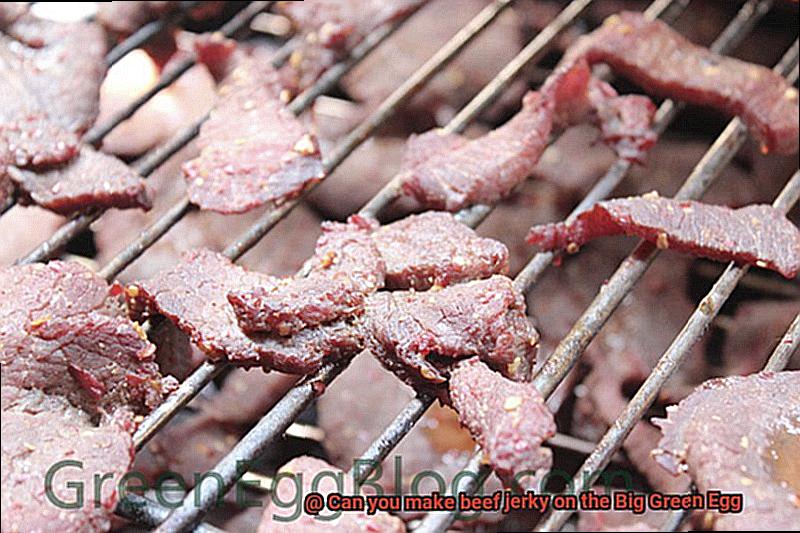
Arranging and Cooking the Jerky
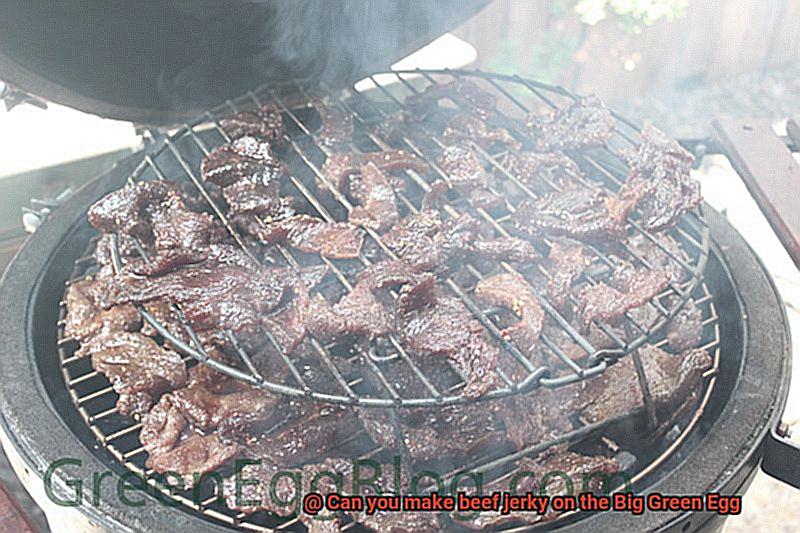
Prepare to elevate your grilling prowess as we embark on a journey into the realm of creating tantalizing beef jerky on the illustrious Big Green Egg. Transform your backyard into a culinary sanctuary where flavors intertwine and tastebuds rejoice. But before we dive into this flavor-packed adventure, let’s ensure that our beloved grill receives the tender loving care it deserves, setting the stage for an unforgettable experience.
The first step in achieving the perfect texture and flavor when cooking beef jerky on the Big Green Egg is arranging the jerky with precision on the grill. Lay out the strips of beef in a single, unobstructed layer, ensuring they do not overlap. This meticulous arrangement allows heat to dance around each piece, guaranteeing even cooking. After all, no one wants some pieces to be overcooked while others remain woefully undercooked.
To prevent any unwanted sticking and to simplify the flipping process, employing a rack or mesh grilling mat is highly recommended. Not only do these ingenious tools make your life easier, but they also safeguard the integrity of your precious jerky.
Now, let us delve into the intricacies of the cooking process. Maintaining a consistent temperature is pivotal in achieving that elusive jerky perfection. Prepare your Big Green Egg for indirect cooking by utilizing a convEGGtor or plate setter. This clever move ensures that heat is distributed evenly, shielding the jerky from direct flames.
The ideal temperature for crafting delectable beef jerky hovers around 160°F (71°C). This slow and steady cooking method allows for gradual dehydration while preserving the meat’s succulence and flavor. To attain this temperature, opt for hardwood lump charcoal to ignite a cleaner and more enchanting burn.
Once your Big Green Egg reaches the desired temperature, gracefully place your meticulously arranged jerky on the grill grates or rack. As you close the lid, let enchantment unfold before your eyes. The cooking time may vary depending on factors such as meat thickness and desired dryness level.
During this magical cooking process, you have the option to infuse your jerky with additional flavor by introducing wood chunks or chips. Soak them in water for approximately 30 minutes before nestling them amongst the charcoal. Hickory, mesquite, or applewood reign supreme in the kingdom of smoky and aromatic tastes.
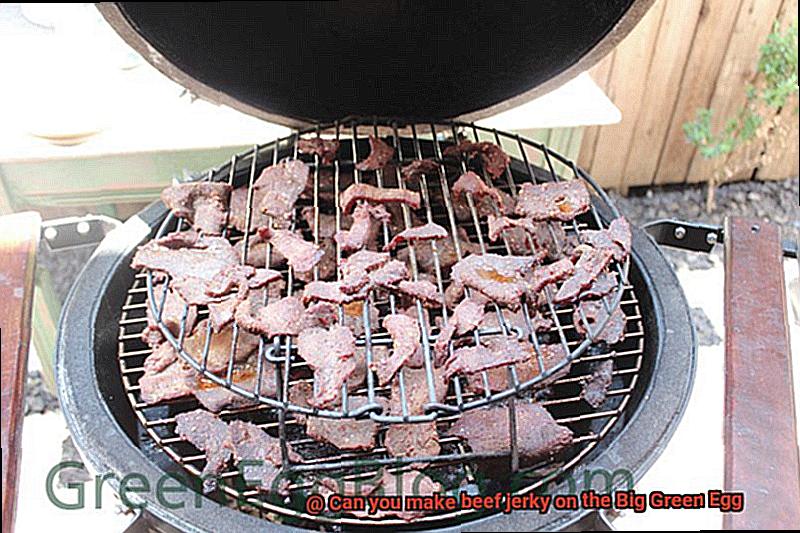
Vigilance is key as you monitor your jerky’s progress, ensuring it does not become excessively dry. The texture should be firm yet slightly pliable when done. If you find your jerky to be overly dry, you may have cooked it for too long or at too high a temperature.
Once your jerky has reached the pinnacle of dryness, delicately remove it from its haven within the Big Green Egg and allow it to cool gracefully before storing it in an airtight container. With proper storage, your beef jerky can retain its delectable qualities for several weeks or even longer if kept in a cool, dry sanctuary.
Monitoring and Flipping
As you embark on this culinary adventure, it is crucial to understand and master the techniques of monitoring and flipping. These simple yet essential steps will ensure that your beef jerky turns out perfectly cooked, tender, and bursting with flavor.
Monitoring: The Key to Cooking Perfection
To achieve beef jerky nirvana, maintaining a consistent temperature is paramount. The low and slow cooking method on the Big Green Egg demands vigilance and precision. Aim for an ideal temperature of around 160°F (71°C) to dehydrate the meat without overcooking it.
To monitor the temperature effectively, equip yourself with a digital meat thermometer or a grill thermometer. Place the probe near the meat, ensuring it avoids bones or fat, and secure it firmly. This allows you to keep a close watch on the internal temperature and make any necessary adjustments to maintain the optimal heat required for perfect jerky.
Flipping: The Dance of Texture and Flavor
Flipping your beef jerky throughout the cooking process is just as vital as monitoring. This step ensures even drying, prevents any side from becoming overly dry or burnt, and aids in distributing flavors and marinades evenly throughout the meat.
The frequency of flipping depends on personal preference and the thickness of your beef slices. As a general rule, flipping every hour is an excellent starting point. However, trust your instincts and adjust accordingly. If one side is drying out faster than the other, more frequent flipping may be necessary.
When it’s time to flip, handle each piece gently with tongs or a spatula to avoid breaking or tearing the precious meat. Take note of any areas that may be cooking faster than others, and if needed, rearrange the placement of the jerky on the grill grate for consistent cooking.
Conclusion:
Monitoring and flipping are the secret ingredients to achieving beef jerky perfection on the Big Green Egg. By closely monitoring the temperature, you create an environment conducive to consistent and tender results. Flipping ensures even drying, flavor distribution, and prevents any side from being left behind.
Testing for Doneness
Today, we’re taking a deep dive into the world of mouthwatering beef jerky cooked on the Big Green Egg. But before we get lost in the tantalizing aroma and smoky flavor, let’s talk about the crucial step of testing for doneness.
When it comes to beef jerky, testing for doneness is an art form. Not only does it ensure that your jerky is safe to eat, but it also guarantees that it reaches its peak deliciousness. So, how do you know when your jerky is perfectly cooked? Let’s explore some tried-and-true methods:
First up, we have the Bend Test. Take a piece of your jerky and give it a gentle bend. If it gracefully flexes without breaking, it means your jerky is not yet fully dried. But if it snaps or cracks, congratulations – your jerky is ready to be devoured. This method allows you to gauge the texture and flexibility of the meat, giving you a clear indication of its doneness.
Next on the list is the Moisture Test. Tear apart a piece of jerky and examine the center. If you encounter any moisture or detect a hint of softness, it’s a sign that more time on the grill is needed. The ideal jerky should be dry and firm throughout, with no trace of moisture or tenderness.
For those who prefer precision, we have the trusty Meat Thermometer method. Simply insert the thermometer into a few pieces of jerky and check the internal temperature. The USDA recommends a minimum internal temperature of 160°F (71°C) to ensure safety. By monitoring the temperature, you can ensure that any harmful bacteria or pathogens are eliminated during the drying process.
Remember, different cuts and thicknesses of meat require varying cooking times. Thinner slices will dry faster than their thicker counterparts, so keep a watchful eye on each piece and remove them as they reach perfection. A little patience and attentiveness will go a long way in achieving the ideal texture and flavor for your jerky.
But don’t forget to trust your senses. Your jerky should possess a leathery texture and be completely dry to the touch. It should be firm, yet still possess a subtle flexibility. If it feels rubbery or overly soft, it’s an indication that it needs more time on the grill to achieve that coveted perfection.
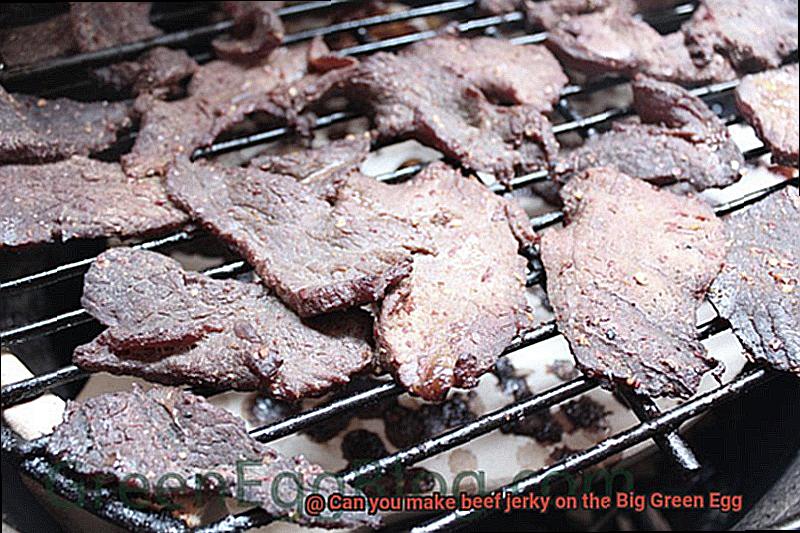
Storing and Enjoying Beef Jerky
Storing and enjoying beef jerky is a culinary adventure that combines convenience, flavor, and versatility. It’s a tantalizing treat for jerky connoisseurs and a secret weapon for grilling enthusiasts looking to add some pizzazz to their dishes. But the key to maintaining the quality and freshness of this delectable snack lies in proper storage.
Moisture, heat, and exposure to air – these are the enemy combatants you need to keep at bay. Shield your jerky from these villains by transferring it into an airtight container or resealable bag. This simple step prevents oxidation and moisture absorption, ensuring your jerky stays as mouth-watering as the day you bought it.
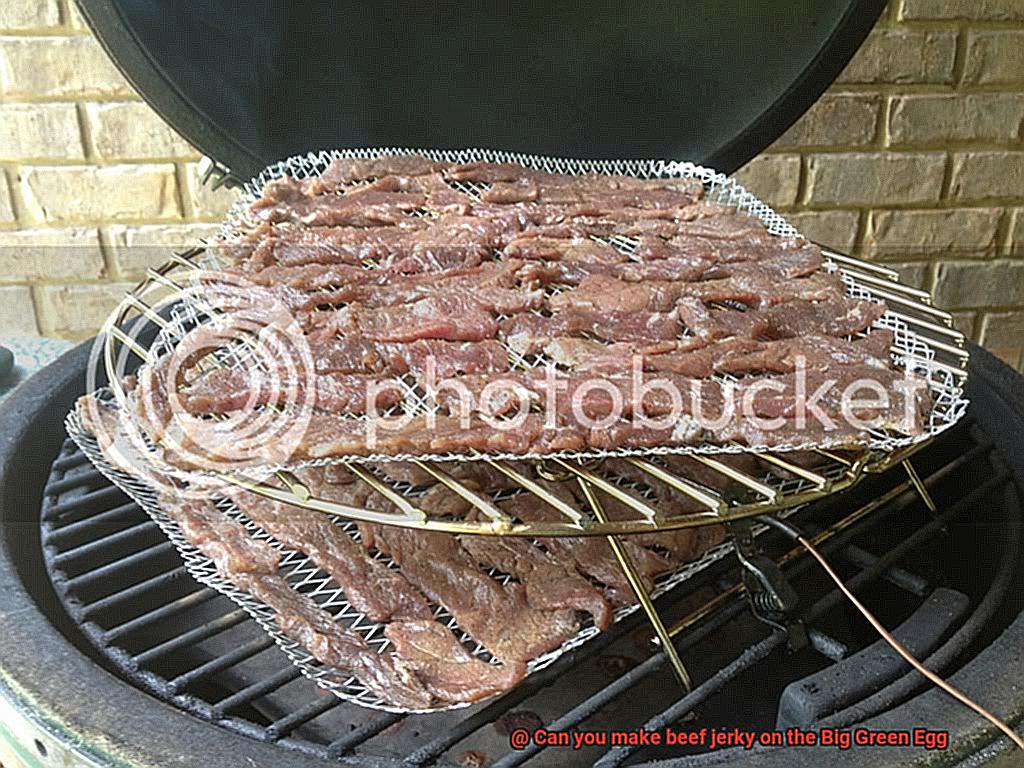
But don’t stop there. Remove as much air as possible from the packaging before sealing it up. This extra precautionary measure maintains the jerky’s texture and flavor, keeping it from drying out or becoming stale.
Now that your precious jerky is safely stowed away, let’s talk about where to keep it. A cool and dry place like a pantry or cupboard is ideal. These areas provide a stable environment that extends its shelf life. Be cautious of high humidity or fluctuating temperatures, though – they can compromise its quality and taste. So keep your jerky away from the stove or refrigerator.
If you really want to maximize its shelf life, consider popping your beef jerky in the refrigerator or freezer. The cold temperatures preserve its freshness for even longer periods. In fact, freezing beef jerky can extend its storage life for up to a year.
When freezing beef jerky, divide it into smaller portions and use freezer bags or vacuum-sealed bags to prevent freezer burn. This way, you can enjoy a tasty portion without having to defrost the whole package.
Speaking of defrosting, when you’re ready to indulge in some frozen beef jerky goodness, let it thaw in the refrigerator overnight for optimal texture and flavor. Patience is a virtue, my friends.
Now that we’ve covered the ins and outs of proper storage, let’s dive into the joy of enjoying beef jerky. It’s as simple as opening the package and savoring its chewy goodness. No additional preparation or cooking required. The intense flavors and tender texture are ready to tantalize your taste buds.
But wait, there’s more. Beef jerky isn’t just a snack; it’s also a secret ingredient that adds a burst of flavor and delightful chewiness to various dishes. Get creative by incorporating it into stir-fries, salads, sandwiches, and wraps. Let your imagination run wild as you elevate your favorite recipes to new heights.
When using beef jerky in recipes, keep in mind that it’s already seasoned and can be quite salty. Adjust the seasoning and salt content accordingly to avoid overpowering your dish.
f2CAmTaMbQY” >
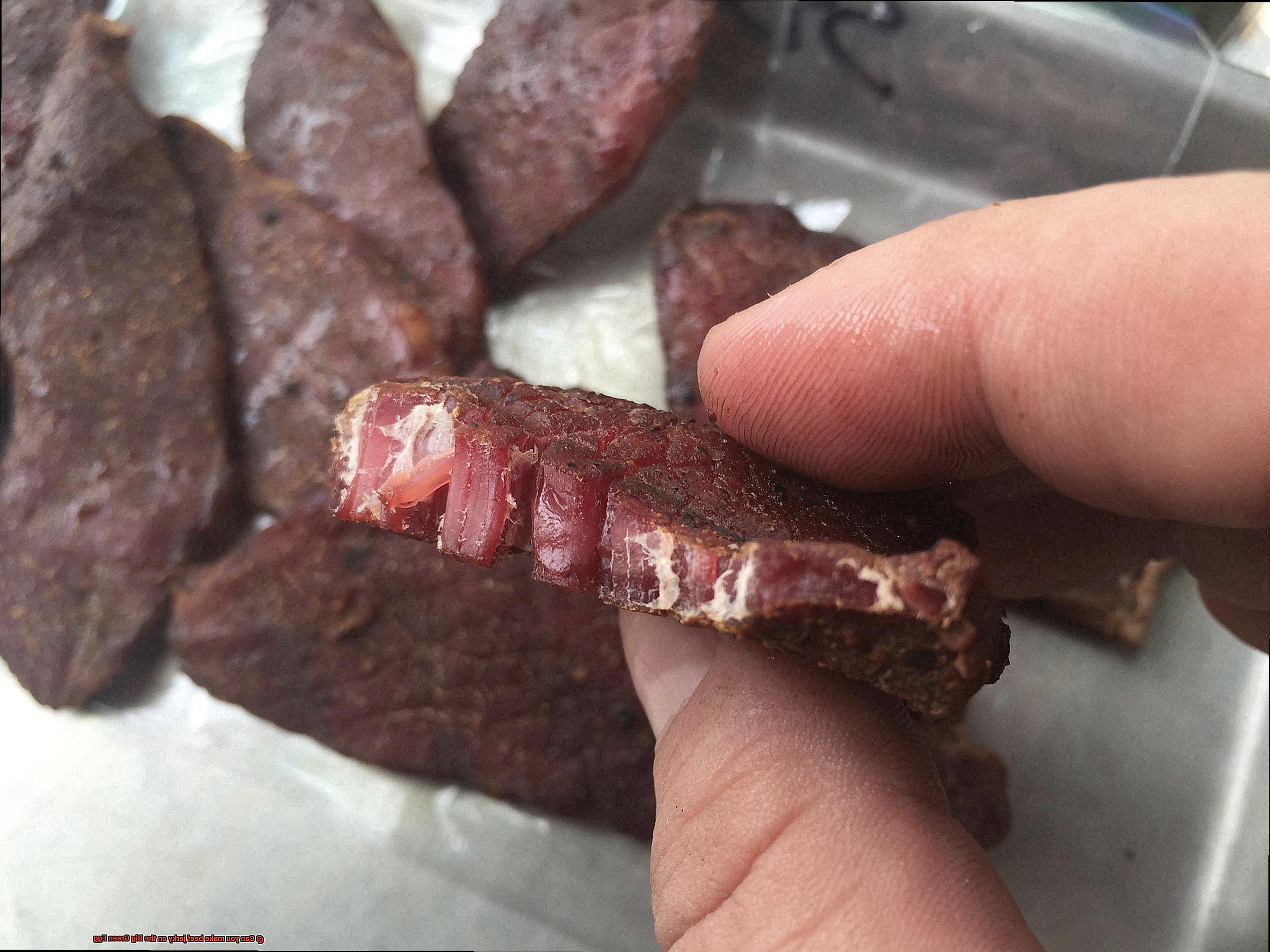
Conclusion
In conclusion, the answer is a resounding yes. The Big Green Egg is not just for grilling steaks or smoking ribs; it can also be used to make delicious beef jerky. With its precise temperature control and ample cooking space, this versatile grill allows you to achieve that perfect balance of smoky flavor and tender texture that makes beef jerky so irresistible.
But making beef jerky on the Big Green Egg is not just about convenience; it’s about elevating your jerky game to a whole new level. The ceramic construction of the Big Green Egg ensures even heat distribution, preventing any hot spots that could result in unevenly cooked or dried-out jerky. Plus, the ability to adjust the temperature with precision means you can experiment with different cooking times and techniques to find your preferred level of chewiness.
Imagine sinking your teeth into thin strips of marinated beef that have been slowly cooked over charcoal, absorbing all those smoky flavors while retaining their natural juiciness. Picture yourself savoring the rich umami taste and satisfying chew of homemade beef jerky that you crafted with care on your very own Big Green Egg.
So why settle for store-bought jerky when you can create your own gourmet version right in your backyard? With the Big Green Egg as your culinary companion, the possibilities are endless. Whether you prefer classic teriyaki or bold and spicy flavors, this grill will deliver exceptional results every time.
In conclusion, making beef jerky on the Big Green Egg is an adventure worth embarking on. So fire up your grill, gather your favorite seasonings, and get ready to experience jerky like never before.

